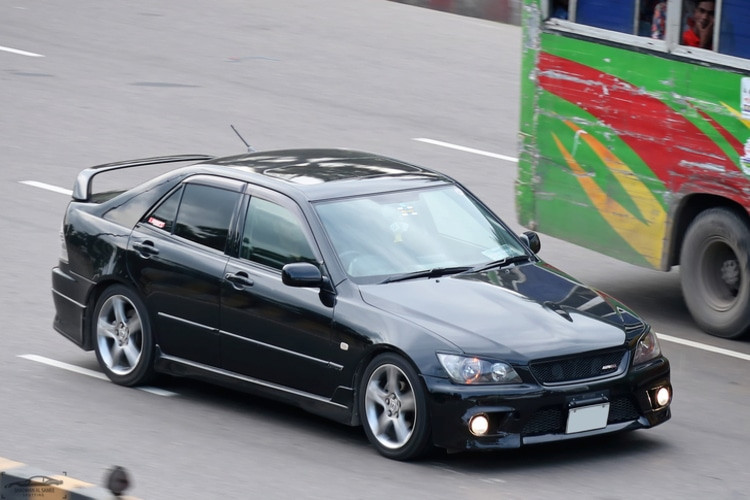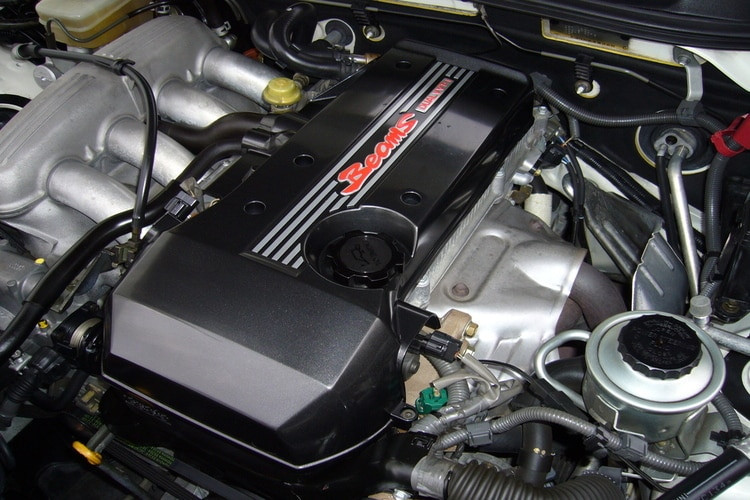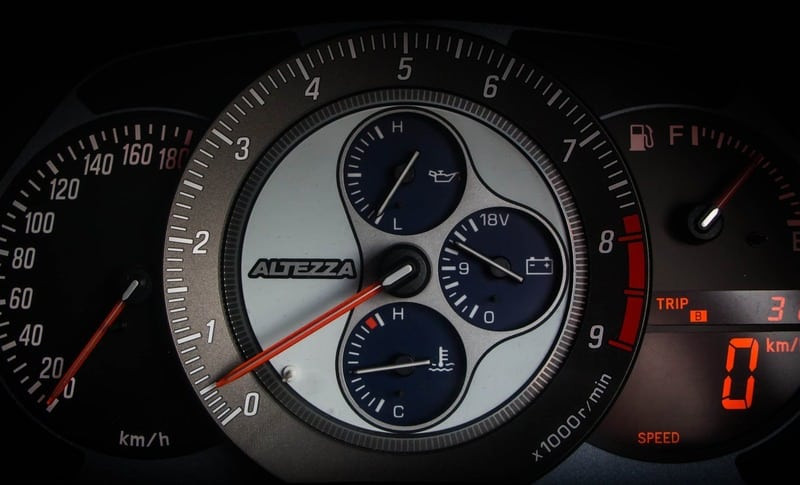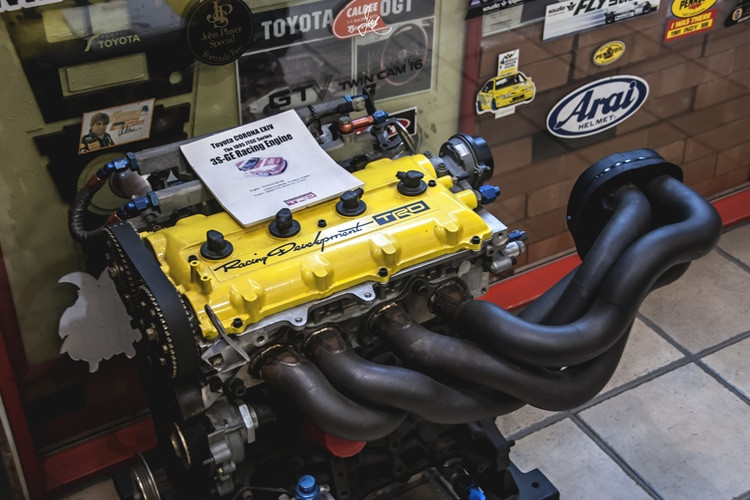Toyota’s journey from a respected Japanese automaker to a global giant selling millions of vehicles annually is a testament to their engineering prowess and understanding of the market. Among their impressive lineup, Toyota has consistently produced exceptional rear-wheel-drive sports cars, many of which remain surprisingly underappreciated.
If you’re familiar with our deep dive into the Lexus IS300 Wagon, you’ll understand this sentiment. The IS300, specifically crafted for the American market, exceeded expectations, achieving over 20,000 sales upon its US debut. But how did Toyota’s designers foresee such success?
Image alt text: Front 3/4 view of a silver Toyota Altezza parked on an asphalt road showcasing its sporty design and alloy wheels.
The Lexus IS300, and even the LS400 (essentially a rebadged Toyota Celsior, as seen above), originated as models intended for the Japanese domestic market (JDM). Toyota strategically rebranded these popular Japanese models as Lexus for the US market, capitalizing on the growing demand for luxury and performance.
Lexus elevated the luxury experience, incorporating premium leather interiors, refined design, and achieving a 5-star IIHS crash test rating. However, let’s shift our focus back to Toyota itself. This is the brand that gifted us icons like the timeless 2000GT, the legendary Supra, the agile MR2, and the modern sports coupe, the GT86. These JDM offerings deliver exhilarating performance and driving dynamics at a more accessible price point compared to their Lexus counterparts, making them incredibly fun to drive.
One particular model that stands out is the Toyota Altezza. If you’re questioning its merits and how it stacks up against a Lexus, keep reading to discover why this JDM gem deserves more recognition.
Decoding the Toyota Altezza
Image alt text: Side profile of a 1991 Toyota Celsior, demonstrating the design lineage and luxury roots shared with later Lexus models.
Let’s revisit the Lexus IS300 for a moment. Visually, the Toyota Altezza is virtually identical to the IS200/IS300. In fact, IS300 body kits are directly compatible with the Altezza. However, the Altezza was exclusively sold in Japan, a key factor contributing to its enhanced driving experience.
Vehicles manufactured for the US market, whether branded as Toyota or Lexus, must adhere to a stringent set of regulations. This often necessitates modifications to certain components, sometimes resulting in a compromise in overall performance. Being a Japan-only model, the Altezza avoided these compromises, retaining its pure, unadulterated JDM essence.
Luxury was certainly not an afterthought in the Altezza’s design. The entire vehicle is crafted to provide a comfortable and refined driving experience. The interior boasts a tasteful black/grey color scheme, complemented by supportive, electronically adjustable semi-bucket leather seats and automatic climate control – features commonly found in contemporary vehicles. Considering its 1998 debut, these were remarkably impressive features for its class.
The Altezza employs a classic front-engine, rear-wheel-drive configuration, a hallmark of sports sedans. It offered a slick six-speed manual transmission as standard, with optional four-speed and five-speed automatic transmissions available on different models. For driving purists and enthusiasts, the six-speed manual is undoubtedly the optimal choice, providing superior driver engagement and control.
Under the hood, the Altezza offered two distinct engine options: the RS200, powered by a high-revving 3S-GE inline-4 engine, and the AS200, equipped with a smooth 1G-FE inline-6. Both engines are renowned for their robust construction and over-engineered design, ensuring optimal power delivery and reliability.
Toyota Altezza: A Legacy Rooted in Performance and Innovation
Tracing Toyota’s lineage of performance cars, one cannot overlook the iconic Corolla AE86. Launched in 1983, the AE86 epitomizes Toyota’s mastery in crafting driver-focused automobiles.
The AE86 featured a responsive 4A-GE inline-4 engine, incorporating advanced technologies like variable intake geometry and electronic fuel injection. Similarly, the Altezza inherited this performance-oriented DNA, boasting standard features such as ventilated disc brakes, power steering, independent strut suspension, coil springs, traction control, and even a limited-slip differential for enhanced handling and grip.
 bodykit jdm street toyota altezza
bodykit jdm street toyota altezza
The AE86 achieved near-perfect 50/50 weight distribution, and its meticulously engineered suspension contributed to handling prowess typically associated with true sports cars. And yes, the AE86, being rear-wheel drive, was a drift machine long before drifting became a global phenomenon.
Nobuaki Katayama, the chief engineer behind the AE86, also spearheaded the Altezza project. This engineering continuity explains why the Altezza delivers a similar engaging driving experience while adding a touch of entry-level luxury refinement.
Toyota Altezza RS200: The High-Revving Performer
The RS200 variant of the Altezza is powered by either the fourth or fifth generation of the 3S-GE inline-4 engine, featuring Toyota’s BEAMS (Breakthrough Engine with Advanced Mechanism System) technology.
These engines are celebrated for their high-revving nature and potent power output. Across the two generations, three distinct variants emerged: Red Top, Grey Top, and Black Top, differentiated by the color of their valve covers.
 toyota ae86
toyota ae86
The Blacktop iteration is considered the pinnacle of the 3S-GE engines. It incorporates lightweight titanium pistons, enhanced camshafts, and produces an impressive 210 horsepower at a screaming 7,600 rpm, with 160 pound-feet of torque at 6,400 rpm.
This particular 3S-GE variant employs a 16-valve configuration, setting it apart from the AS200 and AS300 Altezza models, which we will explore further. The RS200 also features an independent front suspension with a double-wishbone design, a feature shared with the AS200, contributing to its agile handling. For enthusiasts looking to upgrade their suspension, IS300 coilovers are directly compatible with the Altezza, offering a wide range of aftermarket options.
 3sge beams stock engine
3sge beams stock engine
A distinctive feature of the Altezza RS200 is its chronograph-style gauge cluster. While all IS200/300 and Altezza models shared this design aesthetic, the RS200’s cluster redlines at a lofty 9,000 rpm, visually reinforcing the engine’s high-revving character.
Toyota Altezza AS200: The Refined Inline-Six Option
The Altezza AS200 shares the same interior and exterior styling as the RS200, with the primary difference being the gauge cluster, which in the AS200 tops out at 8,000 RPM. Under the hood, the AS200 houses the smooth 1G-FE inline-six engine, an evolution of the third-generation 1G-FE BEAMS, incorporating stronger connecting rods and pistons for enhanced durability.
 altezza rs200 9000rpm cluster
altezza rs200 9000rpm cluster
The engine block of the 1G-FE in the AS200 is constructed from cast iron, paired with a lightweight aluminum cylinder head, mirroring the design of the 3S-GE. Toyota’s engineers prioritized weight reduction in the engine’s design, hence the aluminum head.
The 1G-FE also incorporates VVT-i (Variable Valve Timing-intelligent) on the intake camshaft and features an electronically controlled throttle body for precise air intake management. This inline-six produces a respectable 158 horsepower at 6,200 rpm and 147.6 lb-ft of torque at 4,400 rpm, offering a balanced blend of performance and refinement.
Toyota Altezza AS300: The Practical Wagon Variant
 silver modifed toyota altezza
silver modifed toyota altezza
The AS300, often referred to as the Altezza Gita, is the station wagon/hatchback variant of the Altezza lineup. Visually, the most noticeable distinctions are clear front indicators and an expanded cargo area, resulting in larger overall chassis dimensions to enhance practicality.
The rear seats in the AS300 fold completely flat, and even the front passenger seat can be folded down to accommodate exceptionally long items. The front passenger seat also incorporates a unique tray feature, adding convenience for occupants who wish to dine in the car.
 altezza gita
altezza gita
Powering the Altezza AS300 is the robust 2JZ-GE engine, exclusively paired with an automatic gearbox. This model boasts the highest power and torque figures among the Altezza variants, delivering 227 horsepower and 220 pound-feet of torque. This engine shares a 10.5:1 compression ratio and a 24-valve configuration with the smaller 1G-FE used in the AS200.
Toyota Altezza vs. Lexus IS300: Delving into the Differences
The Toyota Altezza was conceived as a sports sedan for the Japanese market, drawing inspiration from the AE86 Corolla and debuting in 1998.
The Lexus IS, introduced in 1999, was strategically positioned to compete with leading European luxury automakers, emphasizing performance and reliability, distinguishing itself from other Japanese luxury marques of the time.
As previously mentioned, the IS300 incorporates a redesigned exhaust system with a larger catalytic converter. This, while beneficial for emissions, can slightly restrict exhaust flow, making the IS300 feel marginally less responsive compared to the Altezza, which is known for its quicker revving and higher RPM ceiling.
The IS300 also exhibits slightly poorer fuel economy, averaging around 18mpg, whereas the Altezza models (excluding the AS300) achieve a more economical combined figure of approximately 24mpg.
Toyota Altezza Engine Options: A Trio of Powerplants
The Toyota Altezza offers a diverse range of powertrains across its three main variants. The RS200 is equipped with the high-revving 3S-GE engine, the AS200 features the smooth and refined 1G-FE engine, and the AS300 boasts the powerful 2JZ-GE engine. All three engine families are renowned for their inherent tuning potential and robust tolerance to performance modifications, as detailed below.
Toyota Altezza Tuning and Performance Potential
The 3S-GE engine in the RS200 exhibits exceptional adaptability to performance tuning and a wide array of upgrades. Optimizing the 3S-GE for higher output often begins with upgrading to forged camshafts, especially since the engine already operates at a relatively high compression ratio.
Forged camshafts, when combined with a high-compression forged piston kit and individual throttle bodies, can significantly elevate power output. Disabling the VVTi system can further enhance performance, allowing for an increased maximum rev limit exceeding 9,000 rpm. These modifications can push the 3S-GE’s output to over 250 horsepower.
High-performance camshafts and pistons can be sourced from the 3S-GTE, the turbocharged variant of the 3S-GE, which boasts stronger internal components designed for forced induction. The 3S-GTE famously powered the Toyota Celica GT-Four, demonstrating its inherent strength and performance capabilities.
 3sge fully built
3sge fully built
For more ambitious builds, incorporating 3S-GTE connecting rods, an aftermarket intake system (such as the Apexi Power Intake), an upgraded intercooler, a boost controller, a blow-off valve, 3S-GTE fuel injectors (540cc capacity), a high-flow Toyota Supra fuel pump, an adjustable fuel pressure regulator (like those from AEM), a performance downpipe, a standalone ECU (like an HKS F-CON), and a Garrett turbocharger can yield substantial power gains.
This comprehensive turbocharging setup, running at 17-18 psi (1-1.2 bar) of boost, can propel the 3S-GE beyond 320 horsepower. However, the cumulative cost of individual components can quickly escalate. A more cost-effective approach might involve sourcing a complete 3S-GTE engine, which are often readily available and relatively affordable, and then focusing on turbocharger upgrades.
The stock turbocharger on the 3S-GTE becomes a limiting factor for power targets exceeding 400 horsepower. For such builds, upgrading to a larger Garrett turbocharger, such as the GT28 or GTX30 series, paired with higher capacity 800cc injectors, is recommended.
Further enhancements include porting and polishing the cylinder head and replacing the valves with larger, performance-oriented valves. Aftermarket piston manufacturers like Wiseco and CP offer exceptional forged pistons, although the stock internals can also suffice for moderate power increases. For connecting rods, Eagle H-Beam rods are a highly regarded upgrade for the 3S engine family.
Complementing these upgrades with high-strength ARP head studs, a 3-inch performance exhaust system, and a tunable aftermarket ECU completes the transformation. With these modifications, a 3S-GE can reliably produce 450+ horsepower, transforming the Altezza RS200 into a formidable performance machine.
The AS300’s 2JZ-GE engine, the naturally aspirated counterpart to the legendary 2JZ-GTE from the MK4 Supra, also boasts significant tuning potential, mirroring the 3S engine in many aspects. While the GE variant is lighter than the GTE, it necessitates stronger internal components to handle substantial power increases.
Fortunately, the aftermarket support for Toyota’s JZ engine family is extensive. A wide array of performance parts, including piston kits, camshafts, crankshafts, and other internal components, are readily available for the 2JZ-GE. Off-the-shelf 2JZ-GE turbo kits are also widely available, often incorporating Garrett GTX30 series turbochargers or similar, along with comprehensive component sets including bolt-in 2JZ-GTE pistons and thicker cylinder head gaskets.
Similar to the 3S-GE, sourcing a complete 2JZ-GTE engine swap can sometimes be a more practical and cost-effective route compared to individually upgrading the 2JZ-GE, especially considering the inherent differences between the GE and GTE variants, which may necessitate machining for certain modifications.
The AS200, powered by the 1G-FE engine, can also be tuned, albeit with a similar upgrade path to the 3S and 2JZ engines. Interestingly, a supercharged variant of the 1G engine, designated as 1G-FZE, exists. Furthermore, the turbocharged 1G-GTE can be found in the MK3 Supra, offering potential avenues for forced induction conversions for dedicated tuners.
Toyota Altezza Reliability and Common Issues
The Toyota Altezza is widely regarded as a highly reliable vehicle, with minimal inherent flaws beyond typical wear and tear and the need for routine maintenance.
Most reported issues stem from neglect or inadequate maintenance by previous owners. Some owners have noted minor issues such as trunk leaks or the factory head unit being outdated by modern standards.
The automatic transmissions in earlier Altezza models are older, non-CVT designs. This can result in slightly less smooth shifts and occasional jerking, which, while not detrimental to reliability, can be perceived as less refined compared to modern transmissions. Beyond these minor points, the Altezza enjoys a strong reputation for dependability.
Conclusion: The Toyota Altezza – A JDM Dream Realized
The Toyota Altezza remains an exceptional car to own, even in 2023. Its appeal is particularly strong among younger enthusiasts and those with a passion for car modification and tuning. With its range of underrated engine options, including the potent 2JZ-GE, even a straightforward turbo kit upgrade can unlock a dramatically enhanced level of performance.
Leveraging a wealth of readily available aftermarket tuning parts, many of which are shared with its USDM counterpart, the Lexus IS300, the Altezza’s performance potential is virtually limitless for those seeking to maximize its capabilities.
Furthermore, owning an Altezza adds a touch of JDM exclusivity and enthusiast credibility. For those in the know, the Altezza represents a unique blend of Japanese engineering, sporty driving dynamics, and tuning potential – making it a truly desirable JDM gem.